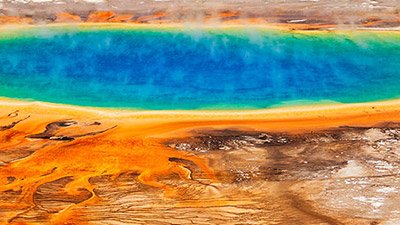
Could a Sudsy Pond Bring Forth Life?
Despite the fact that life has never been observed emerging by random natural processes from non-living elements, most evolutionists are confident that it did. Why?
News Source
- NewScientist: “Bubbles of Fat Hint at Origin of Reproduction”

Fatty acid molecules, because they each have a polar water-soluble end and a nonpolar insoluble end, tend to naturally aggregate in water to form bubbles. If the bubbles get too big, biochemist Jack Szostak has found, they tend to stretch into tubes. Those tubes are fragile, however, and soon break into smaller bubbles, as shown in this diagram from Szostak’s recent publication in the Journal of the American Chemical Society. Instead of adding more fatty acids to feed the bubbles, Szostak has found that evaporating the water they are floating in increases their concentration and is equally effective. Image credit: pubs.acs.org
Despite the fact that life has never been observed emerging by random natural processes from non-living elements, most evolutionists are confident that it did. Why? Because life obviously exists, so they must explain its existence without God. To that end Jack Szostak’s Origins of Life Initiative pursues the possibilities for the recipe for life from scratch.1 “Bubbles of fat hint at origin of reproduction,” published in the 9 January 2013 issue of New Scientist, presents a current distillation of his work.
Szostak believes the key to explaining abiogenesis—life from non-life—is the fatty acid molecule. Fatty acids are a familiar part of everyday life, being a key component of soaps. On a more nuts-and-bolts level, they are also an integral part of cell membranes. Cell membranes keep the insides of cells confined and protected from whatever is outside of the cells. And cells, of course, are the basic building blocks of life.
But living cells must be able to make copies of themselves. DNA forms the genetic code of most kinds of cells, providing the blueprint to guide such replication and directing all cellular activities. DNA is phenomenally complicated, so evolutionists need to explain what simpler sort of “instructions” could have sprung into being naturally before DNA or RNA evolved. Szostak believes that fatty acids could answer this need too.
“Protocells” are the grail for those seeking to explain the origin of life from chemicals. When fatty acids are dissolved in water, they form bubbles. In fact, it is this property of sticking together that makes them such a perfect component for cell membranes. Szostak has long wondered if protocells resembled these fatty bubbles. Fatty bubbles could even replicate themselves, sort of. If he fed more fatty acids to the bubbles, they eventually morphed into fragile tubes that spontaneously broke into new bubbles. Could this be “a crude form of cell division” he wondered?
“Protocells” are the grail for those seeking to explain the origin of life from chemicals.
The problem for Szostak’s team was explaining how the fatty bubbles could grow and divide on their own. “Concentration-Driven Growth of Model Protocell Membranes,” published in the 30 November 2012 Journal of the American Chemical Society, reports their solution to this conundrum.2 If fatty acid bubbles were floating around in Darwin’s “warm little pond”—not a salty ocean which would break them up—and then some water evaporated, the increasing concentration would have stimulated the spontaneous “protocellular division.”
Darwin suggested life could have started “in some warm little pond, with all sorts of ammonia and phosphoric salts, light, heat, electricity, etcetera present.” And in contrast to the usual modern evolutionary view that life had a marine origin, some evolutionists have returned to the warm little pond in the form of geothermal pools. See Primordial Soup Debate for more about this model, which Szostak favors.
Evolutionists supporting Szostak’s model for the primordial fatty acid protocell point out that some antibiotic resistant bacteria shed their cell walls (the target of many antibiotics), become blobs, and even morph into tubes before breaking up into daughter cells. Since this process has been observed in the laboratory even when the bacterial genes have been “deleted,” it appears that this “crude form of cell division” is a property of the cell’s membrane. (Not a surprise of course, since cell membranes are primarily composed of fatty acids.)
So is this plausible? Could life have started this way? No. Scientific claims are supposed to come from observations and experiments, and no scientist has ever observed life randomly emerging from non-living elements. These bubbles of fat could go on aggregating and breaking up forever, in an environment where the water concentration waxed and waned, but that does not make them alive. That does not equip them with the genetic blueprint to produce a real cell or a real multicellular organism that can reproduce.
Scientists have never observed any mechanism by which living things could spontaneously generate the information to become different, more complex living things.
Scientists have never observed any mechanism by which living things could spontaneously generate the information to become different, more complex living things. Neither can observable random natural processes explain the origin of any genetic information without a living source.
Szostak’s work describes the behavior of the fatty acid components of cell membranes, but it does not explain the origin of life. Speculation along those lines is actually quite un-scientific, as abiogenesis violates the basic observable principles of biology.
The Bible provides God’s eyewitness account of the time, about 6,000 years ago, when He created all things and all life and all biological principles by which they operate. If we want to understand the origin of life, we should look to its Source. If we want to understand how life functions or operates today, that is what operation (experimental) science can discover. But the origin of the first living cell (and all other kinds of biological life) is a historical question that can only be correctly answered on the basis of the testimony of the only eyewitness, the Creator. That testimony is in the Bible.
Further Reading
- Primordial Soup Debate (warm pond or hot salty ocean?)
- The “Right Hand” of Evolution (chemical origins of life)
- TNA Stirs Alphabet Soup, Returns Empty (genetic irreducible complexity)
- From Dust to Dust
- Yeast Begat Yeast (yeast begat yeast)
- Don’t Creationists Deny the Laws of Nature?
- Louis Pasteur’s Views on Creation, Evolution, and the Genesis of Germs
- An Evaluation of the Myth That “Nothing in Biology Makes Sense Except in the Light of Evolution”
For More Information: Get Answers
Remember, if you see a news story that might merit some attention, let us know about it! (Note: if the story originates from the Associated Press, FOX News, MSNBC, the New York Times, or another major national media outlet, we will most likely have already heard about it.) And thanks to all of our readers who have submitted great news tips to us. If you didn’t catch all the latest News to Know, why not take a look to see what you’ve missed?
(Please note that links will take you directly to the source. Answers in Genesis is not responsible for content on the websites to which we refer. For more information, please see our Privacy Policy.)
Recommended Resources

Answers in Genesis is an apologetics ministry, dedicated to helping Christians defend their faith and proclaim the good news of Jesus Christ.
- Customer Service 800.778.3390
- © 2024 Answers in Genesis



